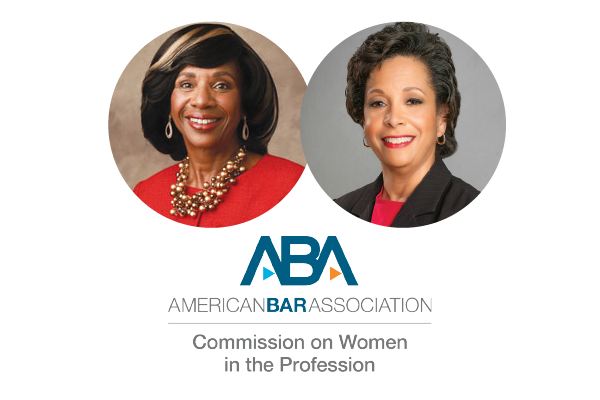The BBA recently hosted a discussion featuring Paulette Brown and Eileen Letts, two authors of a study recently published by the ABA Commission on Women in the Profession, also written by Destiny Peery, that demonstrates the urgency for change in the legal profession.
Left Out and Left Behind: The Hurdles, Hassles, and Heartaches of Achieving Long-Term Legal Careers for Women of Color
The Boston Bar Association hosted Left Out and Left Behind: A Discussion on Women of Color in the Legal Profession featuring Paulette Brown (Chief Diversity Officer, Locke Lorde LLP) and Eileen Letts (Partner, Zuber Lawler & Del Duca LLP), two authors of Left Out and Left Behind: the Hurdles, Hassles, and Heartaches of Achieving Long Term Legal Careers for Women of Color, published by the ABA in 2020. The discussion was hosted by Tracey West, (Chief Diversity & Inclusion Officer at Wilmer Hale). The recording is free to watch (note that a free BBA website account is required for access). As noted in the description of the November 2020 BBA program,
The report itself shows that:
- women lawyers of color surveyed were far more likely to want to leave the profession than their white colleagues
- were more likely to be subjected to both implicit and explicit bias
- were more likely to report factors that blocked their “access to success,” including access to business development opportunities, being perceived as less committed to career and being denied or overlooked for promotion.
The study was the first to focus on women of color who achieved long-term careers in the legal profession. The report reviews the research it builds on, including a 2006 ABA study titled Visible Invisibility: Women of Color in Law Firms (summary here), a 2009 study on women of color in law firms by Catalyst, a 2018 report from the Commission on Women in the Profession that discussed the impact of gender and racial biases, and a 2019 study on women in the workplace that demonstrated advancement disparities by race and gender. Paulette Brown began the BBA program with the foundational point that experiences of women of color are distinct and get lost in studies of all women, and also provided the important reminder that women of color are not a monolith. Paulette and Eileen noted the challenges of conducting the study, including that participating in focus groups required time many could not spare, and that it was difficult to find participants because of the lack of representation. While women in general represent 22% of large law firm equity partners, women of color represent approximately 2%, and Black women in particular represent less than 1%.
We encourage those in the legal profession listen to the full discussion and read the full report, both full of critical insight. Eileen shared that women of color consider leaving the profession more often than others — but they tend to stay, very often because they love the law but also because they felt responsible as role models (among family, in the law firm, and in the community) and financially; many faced additional pressures as first generation students in law school and college, and are active contributors in their communities. Eileen also highlighted the importance of sponsors in addition to mentorship needs, explaining that mentors talk to you (which is important) but sponsors talk about you, e.g. when you aren’t in the room where a connection or decision is happening. Discussing the impact of the barriers women of color face, Paulette highlighted how after women of color demonstrate their skills, they need to prove it again (and again, and again) to overcome others’ biases, whether implicit or explicit. Both the BBA program and full report include much more information that everyone in the legal profession needs to know.
Related Resources:
Amplifying Unheard Voices Series (Boston Bar Association)
- The Black Male Perspective in the Massachusetts Legal Profession
- The Black Female Perspective in the Massachusetts Legal Profession
Black Male Lawyers Detail Racial Bias Inside and Outside Big Law (Arriana McLymore, Thomson Reuters)
New Toolkit: Guided Conversations (ABA Women in the Profession). “Guided Conversations addresses the specific intersectional challenges faced by women lawyers of color and provides recommendations for structured dialogue so women lawyers of color and white women lawyers can find common ground. The toolkit includes a new research report and tools for starting a conversation on gender, race, and ethnicity at your legal organization.”
Bias Interrupters (ABA Diversity & Inclusion Center). “In partnership with the Minority Corporate Counsel Association (MCCA), the Commission is proud to release a research report, You Can’t Change What You Can’t See, designed to reduce the effects of bias in law firms and corporate legal departments. The survey data were prepared by the Center for WorkLife Law at the University of California – Hastings.”
5 Concrete Steps Law Firms Can Take to Advance Diversity, Equity, and Inclusion (Above the Law, 2021). “It’s all about intentionality, according to Yusuf Zakir, Chief Diversity and Inclusion Officer at Davis Wright Tremaine.”
What an Anti-Racist Business Strategy Looks Like (Laysha Ward, Harvard Business Review). “Confronted with protests against systemic racism in the United States, companies are now working to ensure that their workforces and communities are more diverse, equitable and inclusive. But what does anti-racist business strategy look like in practice? There is no one-size-fits all approach, but you can focus on four foundational and four functional elements to stand up successful initiatives. This includes figuring out the purpose of the action you are taking, including many perspectives and people, and measuring how you perform against goals. You will also want to rethink the way you do purchasing and philanthropy, review your policies, and reengage with the places in which you operate.”
The Avant-Garde: A Fundamental Rethink of the Inclusion and Diversity Professional of the Future (Bendita Cynthia Malakia, Modern Lawyer). “The avant-garde is not simply a cost-centre, but is an independent revenue generator, a catalyst to facilitate increased work opportunities for timekeepers and a facilitator to deepen client relationships.”




